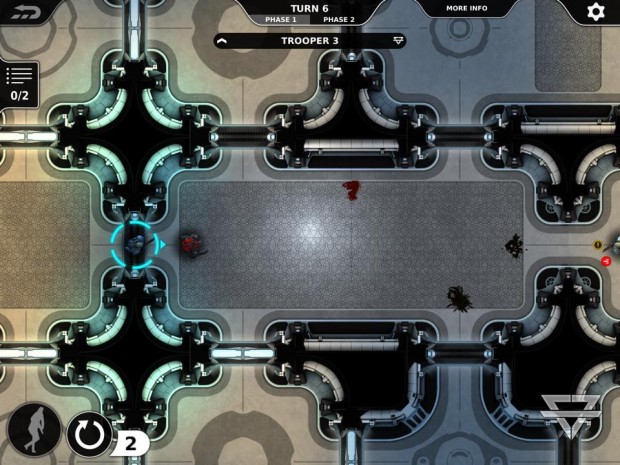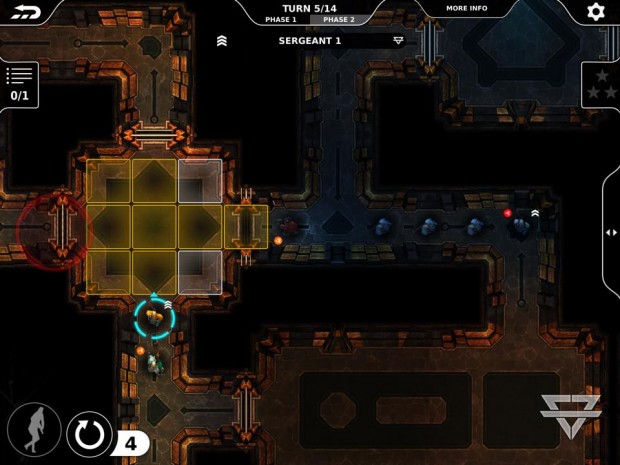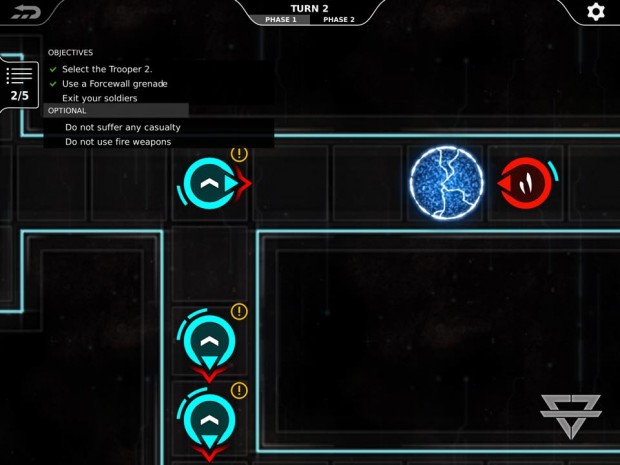 If there is one thing an iPad is definitely great for, it’s digital board and card games. Such games can get a little crowded with the user interface. Especially tactics heavy turn based strategy games in the vein of Space Hulk ($4.99) and the Hunters ($1.99) series. Hey! Speaking of those titles, I played a lovely little strategy game recently that is basically their illegitimate love child! It’s called Legions of Steel ($9.99), and it offers an extremely diverse array of strategic gameplay exclusive on the iPad.
If there is one thing an iPad is definitely great for, it’s digital board and card games. Such games can get a little crowded with the user interface. Especially tactics heavy turn based strategy games in the vein of Space Hulk ($4.99) and the Hunters ($1.99) series. Hey! Speaking of those titles, I played a lovely little strategy game recently that is basically their illegitimate love child! It’s called Legions of Steel ($9.99), and it offers an extremely diverse array of strategic gameplay exclusive on the iPad.
Legions of Steel was originally a board game developed by the peeps Clark Browning, Marco Pecota and Derrick Villeneuve. It was recreated digitally by French developer Studio Nix, and published by the ever pervasive strategy game publisher, Slitherine. Now that I’ve got the credits out of the way, we can set the scene. There is a monstrous scourge of machines, simply called The Machines, spreading through the galaxy. These machines have a twisted sense of aesthetic for some reason. Maybe it’s actually very effective psychological warfare, I don’t know. A united league of 11 alien races bestow better technology upon the weak scrub races of the galaxy, including mankind, for a better fighting chance. Having played a lot of Warhammer 40K and Starcraft, these humans immediately invent highly armored space marines and go off to war.
The story, I should note, is told entirely through simple but gorgeous comic book like cut scenes. No sound or voice acting, but great bold art, which is also present in the general map designs. The gameplay is much less simple, however. You’ll command squads of commandos through the dark metal hallways of ships and bases, including standard troopers, heavy troops, a corporal, and a sergeant. You have a set amount of movement points per round, or phase, as the game calls them. These are used to step, turn, and open doors. You can choose to stand still, walk, or run to affect your movement options, but they’ll also incur different penalties for firing accuracy. Firing is a separate action from movement. You can always fire no matter how much you’ve moved.
Speaking of firing. You have a lot of firing options. You have standard fire, auto fire which doubles your number of attacks and lets you attack adjacent squares in succession, and suppression fire, which lets you cover a long line of squares whereby you attack anything that moves into and within your line. If a unit doesn’t fire on its turn, it will automatically shoot any enemy that moves into its line of sight during the enemy phase. You also have advanced covering options. You can cover a specific square, unit, or shooter, and you can interrupt a particular shooter. Finally, you have pulse grenades which can be thrown around corners, and force walls which block fire until they are destroyed.
So while daddy Space Hulk and mommy Hunters might have more units or weapons, Legions of Steel has tons of tactical options. When firing, there is a percent chance to hit. Personally, I’m not fond of strategy games that employ random chance. When you shoot an enemy 3 times at a few squares away and a 66% chance to hit and miss each time, it’s kind of infuriating. On the other hand, it lends a boat load of tension to the game. See, every unit dies in one single hit. No exceptions. I would think this would call for a more pure strategic experience, but the random chance does make each turn or each risky move much more tense. Overall, this game definitely falls on the hard side. Maybe a little too hard. I’ve never been great at strategy games. You can tell me to “Git Gud” but I’d definitely say this game is a bit unfair, or unforgiving at the very least.
That doesn’t necessarily make it bad, of course. But at ten dollars, it’s probably not worth the investment unless you really dig the genre. But it wouldn’t be a Slitherine title if it wasn’t at least a tad on the pricey side. The game is severely lacking in visual variety. The 3D model units are only OK, and while the maps are nice, they are extremely visually repetitive. Though there is a neat purely tactical visual mode to toggle with a 3 finger touch.
They make up for the lacking visuals with a lot of content. The tutorial campaign features 20 levels and 6 story bits. Each level gives you a very specific set of goals to achieve. It’s a very long tutorial, and it gets a little tedious, but it is necessary to learn everything, with optional objectives thrown in for mastery’s sake. I haven’t even mentioned the ‘Electronic Warfare’ fog of war mechanic that occasionally shows up. Things can be a little buggy in the tutorial. If you don’t follow the level instructions immaculately, the level can bug out entirely. It also once told me I had casualties when I had none, and it said I didn’t have any casualties when I definitely did. Take that for what it is.
Even the tutorial can be difficult at times, but then the game stops holding your hand for the main campaign, which is 10 missions long. In the main campaign, things are much less guided. You’ll sometimes be able to choose where to spawn which unit, and they even add a super basic leveling system for the Corporal and Sergeant units, which lets you upgrade armor, accuracy, range, rate of fire, and move points. You’ll also have to roll initiative against The Machines before every phase to decide who goes first, and the winner gets to choose who does go first. You also get full access to the leadership point system. You get three leadership points, or stars, every phase, which can be used to improve your initiative roll, add movement points to units, or improve their accuracy. They also let you use the ‘dodge’ movement to get out of harrowing situations.
Trigger Warning: The following trailer has abysmal voice acting. You’ve been warned.
When you’re done with the campaign, you can play in Skirmish mode, same device multiplayer in Hotseat mode, and the cross-platform asynchronous online multiplayer. As of right now, there are a handful of active players at least, with 15 maps/scenarios to enjoy. My final point of criticism is in the user interface and sound effects. Generally you just hear the droning sci-fi track and it feels very empty. This could be intentional since space is supposed to be quiet and scary, but it still feels too quiet. In fact, this is one of the only times I’d ever say that there is too much atmosphere. The ambience is overpowering. The Interface itself could use more sound effects. Different audio cues to better remember and punctuate the numerous settings and options.
Sure, the game lacks the polish of its parents. And sure, you can find games with more visual variety, features, and assets for around half the price. But the game on offer here is definitely solid for what it is. If you’ve already played all the other hot ticket strategy games on the market, this one will definitely scratch your itch. But if you’re not huge on the genre, you may just want to give this one a pass.


